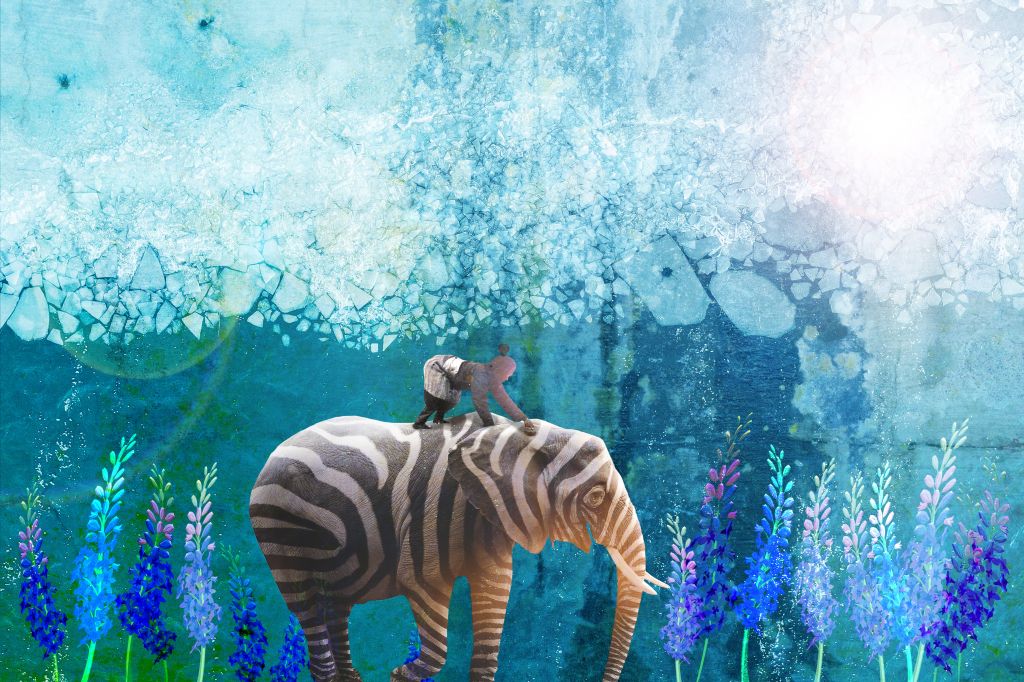
Ivínguak’ Stork Høegh (b. 1982)
Nuuk Art Museum hosted the talk scene Reflecting Nuuk Nordic at Nuuk Nordic Culture Festival 2023 in collaboration with the Nordic Institute in Greenland (NAPA) and the Sami artist collective Dáiddadállu. The talk scene dealt with topics like coloniality, Arctic and Nordic relations, artists’ wellbeing and more. The artist Ivínguak’ Stork Høegh created a photo collage for this scene that aligns with her series ArcticExotic, where she puts Arctic motifs side by side with animals from the African savanna; challenging the viewer’s view of Greenland. In both the ArcticExotic series and this piece, Stork Høegh has used multiple photographs – either taken from databases or her own – which she has digitally layered on top of each other, after which colors and drawings have been graphically added.* In this piece, she has used a photograph of an Inuk woman using her ulu, but Stork Høegh has chosen to place her on top of an African elephant, whose photograph was clearly taken somewhere far from the Arctic. The elephant is decorated with of zebra stripes, and it is surrounded by blue lupines (flowers), drawn by Stork Høegh. At the top of the piece, an ice sea is breaking apart while the sun, gives the collage a green, kaleidoscopic hue.
In many ways, the piece is absurd. The Greenlandic woman and the African elephant have never met in real life. It is not even certain that the woman knew that elephants existed, yet she is now sitting on top of one while she is cutting the elephant open with her ulu. The image is made even more absurd by the fact that the elephant has zebra stripes, which reinforces the notion that the elephant is a unique and imaginary creature in the eyes of the woman. The art piece creates an unreal, adventurous, colorful universe – a pure fantasy. But even though the woman and the elephant seem incompatible, and are living at opposite ends of the globe, they still have something in common: They are exotified. In the eyes of the Western world, both Africa and the Arctic are seen as unreal places, located far from the lives of Western people.* But Africa and the Arctic are real places with real people – they are not someone’s exotic fantasy. When the real and the unreal meet in this piece, the viewer’s gaze is challenged: Are you looking at your own idea of what “the exotic” is?*
The exotic and the colonial are inextricably linked. When outsiders colonized Africa and the Arctic, they created their own narratives about “exotic” places.* The places were explored, documented and investigated through large expeditions, and the colonizers infiltrated and invaded all aspects of these societies. Although the lupines in this piece that surround the woman and the elephant are beautiful, they are an invasive species that spread quickly and set deep roots. The lupines were brought from Europe, and are now threatening Greenlandic flora.** In the same way, the elephant and the Inuk woman are also threatened. The African elephant is an endangered species, while the traditional way of life of the Inuk woman soon belongs to the past. However, the art piece is not a way of accusing or blaming anyone, despite the themes of colonization and exoticism.* Instead, Stork Høegh challenges how colonial history is viewed. She believes that colonialism is a part of Greenland’s history, and has affected the country and the people still to this day.* Through the intertwining of the Arctic and Africa in her piece, new nuances and views of history and society arise, and the viewer must position oneself towards the meeting of cultures that is depicted.
Ivínguak’ Stork Høegh has attended Greenland’s School of Art, and Århus Kunstakademi where she specialized in mixed media/graphics. She later attended Teknisk Skole in Århus, where she studied media graphics, and completed her education in Copenhagen***. She worked at Kalaallit Nunaata Radioa & TV for a number of years, and became headmaster of Greenland’s Art School in 2021.
This article was written by Karoline Støjbjerg Sejersen. 2023.
References:
* SLundberg Hansen, Stine. Ivinguak Stork Høegh viser, at det eksotiske er en kategori, der afhænger af, hvem der ser. Kunsten.nu, 15th of July 2021: https://kunsten.nu/journal/ivinguak-stork-hoeegh-viser-at-det-eksotiske-er-en-kategori-der-afhaenger-af-hvem-der-ser/
** Betak, Jens. Farlig skønhed: Lupinen kvæler lokale planter i Sydgrønland. KNR.gl, 8th of July 2019: https://knr.gl/da/nyheder/farlig-sk%C3%B8nhed-lupinen-kv%C3%A6ler-lokale-planter-i-sydgr%C3%B8nland
*** KIMIK ukiut 20 år. milik publishing. 2016.
